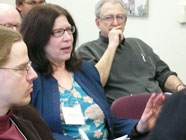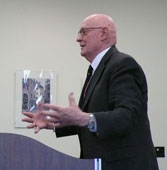::: center home >> being here >> last donut? >> underdetermination |
21 March 2009 Kyle Stanford is visiting the Department of History and Philosophy of Science this term. He is the expert in the topic of underdetermination in philosophy of science. So we thought we should seize the moment and organize a workshop on the topic with Kyle at its core. So was born the "Kylefest," as it instantly came to be know in all our internal documentation. Kyle and I formed a little organizing committee and started to solicit speakers.
The community separates along these lines. I belong to the latter group. I see underdetermination as a bump in the road of science. The passage of science may be rockier when the science is newer and more esoteric, but generally these bumps get smoothed out as we get smarter in our analyses. Why, I wonder, do my colleagues spend so much time worrying about it? On the other side is the view that this sort of underdetermination is pervasive and unavoidable. We see it most prominently in newer theories; but it affects them all. Our scientific consensus does stabilize. That creates an illusion that the evidence has determined the right theory. But it is only an illusion since our choice of theory is conditioned by other factors many of which are invisible to us. Our workshop, we hoped, would be a productive meeting of the two sides. I was looking forward to seeing both sides laid out in their many variant formulations and to advancing the discussion in the comfortable context of a small workshop. It was fitting that Kyle should be the first speaker at the Kylefest. He began in a standard way for those who support underdetermination. He reminded us of the doctrine of scientific realism, which holds that our best theories are approximately true. It is threatened if underdetermination prevails and we cannot be assured of the truth of our best theories. A novelty of Kyle's work is the notion of "unconceived alternative." It labels the gap between evidence and theory in way that proves remarkably convenient when we need to capture elusive thoughts about underdetermination in words. If you were a good Newtonian a hundred years ago, you may have thought that all the evidence has given us Newton's mechanics as the one, true theory. But that is only because the alternatives that ruined Newton, relativity and quantum theory, remained unconceived. In principle a similar danger threatens all our theories today and forever. The Newtonian example does not move me. I think Newtonians had overwhelming inductive evidence for their theory. They took a small inductive gamble in accepting it and, famously, lost. But don't we mostly win these gambles? Don't we mostly win when we turn to much more prosaic notions? How could there be any confusion, say, that fossils are just mineralized once-living organisms? How could it be doubted? They are perfect pictures in stone of the beings that engendered them. That example is the case study to which Kyle turned. His point was to illustrate that even in apparently simple cases, all sorts of alternatives may lurk in the neighborhood. In the sixteenth century, when serious discussion of fossils was engaged, it was anything but clear that fossils were mineralized, once-living beings. As Kyle ran through the way things seemed in sixteenth century, I could feel my gestalt switching. Then they did not think as we now do that organic forms can only arise in nature as the result of very specific biological process involving DNA molecules. The processes that generated these forms were more varied and may produce objects that more or less resembled perfected living forms. Why could they not also be working in the ground? And then came the combination laugh line-coup de grace, delivered with just the right level of gesturing. And if you think that these forms were produced by ordinary biological processes, "how did they get into the rocks?!" Kyle's finger poked at an imaginary rock hovering in the space between us. We were on schedule. The arch-defender of underdetermination had just shaken my certainty in some established piece of science. I was imagining the room polarizing into the yeas and nays with an invisible line that snaked down the center of the room. And then Kyle turned everything on its head. That was then, Kyle told us. Now is now. Underdetermination no longer prevails. It has been settled by the science of taphonomy. In it we have been able to observe in the lab the very processes that generate fossils. We have done so at such a level of detail that the most minute accidents of fossilization are now intelligible to us as the result of the mineralization of the once-living. Kyle wrapped up this new turn in more general terms. The older inductive support for the nature of fossils was abductive: we inferred to the best explanation. Such inferences are always at risk of defeat by unconceived alternatives. The modern analysis employs "projection," that is, modest, incremental, generalizations that are not prone the same danger. And that, Kyle informed us, is a great irony. Abduction was introduced and celebrated as remedying the defects of projective induction. Kyle's presentation set the tone for the remainder of the conference. There was no invisible line snaking around the room. No one mounted an unreserved defense of rampant underdetermination in science; just as no one was willing to urge that scientific evidence always has heroic powers of determination. As the workshop and the discussion unfolded, critics of underdetermination, myself included, were cautious in their claims; and support for it was at best mixed.
Nick has a kindly and magisterial presence and I could see him thinking that this was a simple question that could only be given a complicated answer for which we could not possibly have patience. He began to sketch a rich and subtle view, informed by Whewell's 19th century Kantianism and Peirce's pragmatism, and, I expect, if we had time to penetrate it further, we would have arrived at Leibniz's metaphysics. But we did not have time, for our closing event was still to come. We had scheduled a closing free-for-all discussion session, as is common at such workshops. The chairs in the room have been rearranged ingeniously by Peter Gildenhuys and Balazs Gyenis, so that the participants could sit at the front and speak to one another while still keeping the rest of the room engaged. This discussion session, however, had a novel twist. Kyle had written the book on underdetermination, Exceeding Our Grasp: Science, History, and the Problem of Unconceived Alternatives. He was now also writing the article. It is "Underdetermination of Scientific Theory" for the online Stanford Encyclopedia of Philosophy, which has an enviable status as the authoritative, online resource for philosophy. Participants in the workshop were given Kyle's draft ahead of time and the plan was that we would provide editorial feedback. In the abstract, that seemed like a good plan. What draft couldn't use some help, especially from a coven of assembled experts? I'd been busy and didn't get to read the draft until the day before the workshop. My heart sank as I read through it and found it quite uniformly excellent. ("We made a big mistake in choosing to read your article!" I had deadpanned to a startled Kyle on Friday.) Indeed Kyle had put in simple terms something that I had previously found impenetrable: just what was Quine thinking in his obscure but immensely influential remarks on underdetermination?
John D. Norton Saturday-Sunday, 21-22 March 2009 |

























